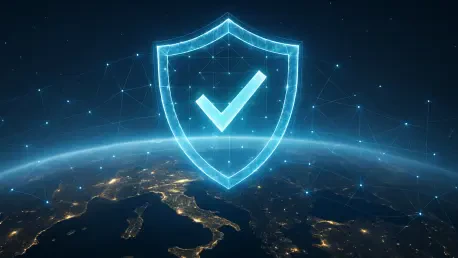In an era where cyber threats are not just a possibility but a daily reality, organizations across the globe are scrambling to protect their digital assets from increasingly sophisticated attacks, with challenges ranging from state-sponsored hackers infiltrating critical infrastructure to insider breaches compromising sensitive data. The stakes have never been higher. Enter Zero Trust, a cybersecurity framework rooted in the principle of “never trust, always verify,” which is rapidly transitioning from a niche concept to a mandatory standard in both governmental and corporate spheres. This paradigm shift is reshaping how data security is approached, driven by urgent policy mandates, escalating financial investments, and the undeniable need to counter pervasive risks. As traditional perimeter-based defenses crumble under modern threats, Zero Trust stands as a beacon of rigorous protection, demanding continuous scrutiny of every user and device. This article explores the forces propelling Zero Trust into the mainstream, the opportunities it presents, and the obstacles that lie ahead in its widespread adoption.
Redefining Security with a Zero Trust Mindset
Zero Trust represents a fundamental departure from outdated cybersecurity models that once assumed trust based on a user’s location within a network. Instead, this approach operates on the premise that no individual or device is inherently safe, requiring constant verification of identity, strict access controls, and ongoing monitoring of all activity. This isn’t merely a technological adjustment but a profound cultural transformation for organizations accustomed to more lenient systems. As cyber threats evolve—spanning ransomware attacks to espionage by foreign entities—the need for such relentless vigilance becomes undeniable. Zero Trust ensures that even if a breach occurs, the damage is contained through minimal permissions and segmented access, preventing attackers from moving freely within a system. This shift is proving critical in safeguarding everything from corporate trade secrets to national security data, positioning Zero Trust as the bedrock of modern digital defense strategies.
The implications of adopting Zero Trust extend beyond just installing new software or updating protocols; they touch every facet of an organization’s operations. Staff must be retrained to embrace a mindset of skepticism toward access requests, while IT teams face the daunting task of integrating these principles into existing infrastructures often built on legacy systems. Furthermore, the model demands a granular understanding of data flows and user behaviors to enforce policies effectively. For many, this means a complete overhaul of how security is perceived and prioritized, moving away from a reactive stance to a proactive one. Industries handling highly sensitive information, such as defense and finance, are finding that Zero Trust isn’t just beneficial but essential to comply with emerging standards and protect against catastrophic losses. This comprehensive rethinking of trust in digital environments underscores why Zero Trust is no longer optional but a cornerstone of survival in today’s threat landscape.
Government Mandates Driving Global Adoption
Government policies are at the forefront of pushing Zero Trust into the mainstream, with the United States leading through decisive action. The Department of Defense has set a firm deadline of 2027 for federal agencies and their contractors to fully implement Zero Trust architectures, a directive that sends shockwaves through global cybersecurity practices. This mandate doesn’t stop at American borders; it influences allies and partners in supply chains across Europe, Australia, and beyond, who must align with these standards to maintain collaboration and interoperability. International bodies like NATO, alongside national frameworks such as Australia’s Cyber Security Strategy, are reinforcing this push by embedding secure-by-design principles into their guidelines. The result is a unified front where Zero Trust becomes not just a policy but a global expectation for securing critical systems against ever-growing threats.
This top-down approach from governments is reshaping cybersecurity on an unprecedented scale, compelling organizations to act swiftly or risk exclusion from key partnerships. The ripple effect of the U.S. mandate means that even private entities tied to federal contracts must adapt, creating a domino effect across industries. Beyond compliance, these policies reflect a broader recognition that digital defense is integral to national security, especially as cyber warfare becomes a tool of geopolitical conflict. For regions like Australia, aligning with such standards through alliances like AUKUS ensures both strategic relevance and access to cutting-edge defense networks. However, the pressure to meet these deadlines also exposes gaps in readiness, particularly among smaller nations or firms lacking resources to overhaul their systems quickly. Despite these challenges, the momentum created by government leadership signals that Zero Trust is the future of cybersecurity policy worldwide.
Economic Impacts and Market Opportunities
The rise of Zero Trust isn’t just a security imperative; it’s a significant economic driver transforming cybersecurity into a thriving industry. In the United States, defense budgets are increasingly channeled toward digital protection, with substantial allocations aimed at meeting Zero Trust goals by 2027. Allied nations are following suit, boosting their own cybersecurity investments to keep pace. On the corporate front, regulatory bodies like the Securities and Exchange Commission and GDPR authorities in Europe are tightening the screws on data breach accountability, while cyber insurers offer incentives for adopting Zero Trust practices. This confluence of factors fuels a robust market for technologies in identity verification, access control, and data encryption, presenting a goldmine for tech providers and investors looking to capitalize on sustained demand across both public and private sectors.
Beyond immediate financial commitments, the strategic implications of this shift are profound for global markets. Cybersecurity is no longer seen merely as a cost center but as a growth engine, with companies specializing in Zero Trust solutions poised for exponential expansion. Sectors like healthcare, finance, and critical infrastructure, where data sensitivity is paramount, are driving demand for innovative tools that ensure compliance and mitigate risks. For investors, this translates into opportunities to back firms developing cutting-edge platforms, from attribute-based access control to real-time monitoring systems. Meanwhile, the economic pressure to adopt Zero Trust also highlights disparities, as larger corporations with deeper pockets can adapt more readily than smaller entities struggling with implementation costs. Nevertheless, the financial landscape shaped by Zero Trust underscores its role as a catalyst for innovation and a cornerstone of economic resilience in a digital age.
Australia’s Strategic Edge in the Shift
Australia stands at a unique crossroads in the global pivot to Zero Trust, leveraging its geopolitical alliances to gain a competitive edge. Through frameworks like AUKUS and the Five Eyes intelligence partnership, Australian technology firms are integrating into international defense supply chains, positioning themselves as key players in secure data solutions. A prime example is archTIS Ltd, a Canberra-based company that has secured contracts with subcontractors of the U.S. Department of Defense by offering Zero Trust-aligned innovations such as attribute-based access control software. These achievements not only validate local expertise but also open pathways to broader markets in regulated industries like healthcare and finance, where stringent security is non-negotiable. Australia’s alignment with global standards thus becomes a springboard for economic and strategic gains.
The success of Australian firms in this arena is a testament to the power of strategic partnerships in amplifying regional influence within the cybersecurity domain. By meeting the rigorous demands of international defense entities, local companies build credibility that extends to commercial sectors hungry for proven solutions. This dual benefit—securing high-profile contracts while expanding market reach—demonstrates how Zero Trust adoption can transform national tech landscapes. However, the journey isn’t without hurdles, as Australian businesses must navigate complex international regulations and ensure interoperability with diverse systems. Despite these challenges, the nation’s proactive engagement with global cybersecurity trends through alliances offers a blueprint for other regions aiming to carve out a niche in this rapidly evolving field. The path forward for Australia lies in sustaining this momentum to cement its role as a trusted innovator on the world stage.
Navigating the Hurdles of Implementation
While the momentum for Zero Trust is undeniable, the road to full adoption is fraught with significant challenges for organizations of all sizes. Large enterprises often face the daunting task of re-architecting sprawling IT infrastructures that were never designed for such granular security measures. This process involves not only technical upgrades but also retraining workforces to adapt to stricter access protocols, often met with resistance from employees accustomed to freer systems. Additionally, the financial burden of overhauling legacy systems can be staggering, requiring substantial investments in both technology and expertise. As cyber threats continue to escalate in frequency and complexity, the urgency to implement Zero Trust clashes with these practical barriers, forcing leaders to balance immediate security needs against long-term operational constraints in a high-stakes environment.
Smaller organizations and suppliers encounter their own set of obstacles in this transition, often lacking the resources to match the pace of larger counterparts. Ensuring compatibility with existing platforms while adhering to a patchwork of international regulations adds layers of complexity to their efforts. Many struggle to integrate Zero Trust principles without disrupting day-to-day operations, a challenge compounded by the need to demonstrate compliance to secure contracts or partnerships. Yet, the cost of inaction remains far graver, as data breaches can devastate reputations and finances in an instant. The drive to overcome these hurdles is fueled by the stark reality of today’s threat landscape, where no entity is immune to attack. Addressing these implementation challenges requires innovative approaches, such as phased rollouts and scalable solutions, to make Zero Trust accessible across diverse organizational contexts.
Future Pathways for Digital Defense
Reflecting on the journey, the ascent of Zero Trust as a cybersecurity standard marked a pivotal moment in how digital threats were tackled across the globe. Governments, led by initiatives like the U.S. Department of Defense mandates, set ambitious timelines that reshaped policies and priorities worldwide. Financial commitments and regulatory pressures further solidified this framework as indispensable, while strategic alliances amplified opportunities for nations like Australia to shine on the global stage. Despite the formidable challenges of implementation, the collective resolve to secure data against relentless risks drove progress at an unprecedented pace. Looking ahead, the focus must shift to scalable solutions and collaborative efforts to ensure Zero Trust becomes seamlessly integrated into diverse systems. Prioritizing education, fostering innovation in accessible technologies, and strengthening international cooperation will be key steps to fortify digital defenses for the evolving threats of tomorrow.









